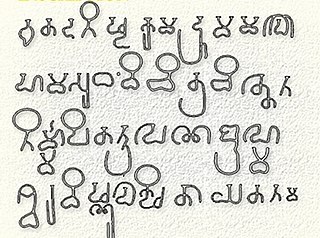
Back Alfabet grantha Catalan Grantha-Schrift German Alfabeto grantha Spanish الفبای گرانتا Persian Grantha Finnish Grantha French ग्रन्थ लिपि Hindi Grantha ID グランタ文字 Japanese Aksara Grantha JV
| Grantha script 𑌗𑍍𑌰𑌨𑍍𑌥 | |
|---|---|
 7th-century inscription in Grantha script at the Mandagapattu Hindu temple | |
| Script type | |
Time period | 7th century CE - present[1][2] (excluding Pallava Grantha) |
| Direction | Left-to-right |
| Languages | Tamil and Sanskrit |
| Related scripts | |
Parent systems | |
Child systems | Malayalam Saurashtra Tigalari[4] Dhives Akuru |
Sister systems | Tamil, Old Mon, Khmer, Cham, Kawi |
| ISO 15924 | |
| ISO 15924 | Gran (343), Grantha |
| Unicode | |
Unicode alias | Grantha |
| U+11300–U+1137F | |
| Brahmic scripts |
|---|
| The Brahmi script and its descendants |
The Grantha script (Tamil: கிரந்த எழுத்து, romanized: Grantha ezhuthu; Malayalam: ഗ്രന്ഥലിപി, romanized: granthalipi) was a classical South Indian Brahmic script, found particularly in Tamil Nadu and Kerala. Originating from the Pallava script, the Grantha script is related to Tamil and Vatteluttu scripts.[5] The modern Malayalam script of Kerala is a direct descendant of the Grantha script.[5] The Southeast Asian and Indonesian scripts such as Thai and Javanese respectively, as well as South Asian Tigalari and Sinhala scripts, are derived or closely related to Grantha through the early Pallava script.[6][7][8] The Pallava script or Pallava Grantha, emerged in the 4th century CE and was used until the 7th century CE, in India.[9][2] This early Grantha script was used to write Sanskrit texts, inscriptions on copper plates and stones of Hindu temples and monasteries.[10][5] It was also used for classical Manipravalam – a language that is a blend of Sanskrit and Tamil.[11] From it evolved Middle Grantha by the 7th century, and Transitional Grantha by about the 8th century, which remained in use until about the 14th century. Modern Grantha has been in use since the 14th century and into the modern era, to write classical texts in Sanskrit and Dravidian languages.[10][5] It is also used to chant hymns[clarification needed] and in traditional Vedic schools.[12]
The Tamil purist movement of the colonial era sought to purge the Grantha script from use and use the Tamil script exclusively. According to Kailasapathy, this was a part of Tamil nationalism and amounted to regional ethnic chauvinism.[13]
- ^ Cite error: The named reference
brittanicawas invoked but never defined (see the help page). - ^ a b Cite error: The named reference
diringerwas invoked but never defined (see the help page). - ^ Handbook of Literacy in Akshara Orthography, R. Malatesha Joshi, Catherine McBride(2019),p.28
- ^ Grantha, Omniglot (2014)
- ^ a b c d Richard Salomon (1998). Indian Epigraphy: A Guide to the Study of Inscriptions in Sanskrit, Prakrit, and the other Indo-Aryan Languages. Oxford University Press. pp. 40–42. ISBN 978-0-19-535666-3.
- ^ J. G. de Casparis (1975). Indonesian Palaeography: A History of Writing in Indonesia from the Beginnings to C. A.D. 1500. BRILL Academic. pp. 12–17. ISBN 90-04-04172-9.
- ^ Patricia Herbert; Anthony Crothers Milner (1989). South-East Asia: Languages and Literatures : a Select Guide. University of Hawaii Press. pp. 127–129. ISBN 978-0-8248-1267-6.
- ^ Pierre-Yves Manguin; A. Mani; Geoff Wade (2011). Early Interactions Between South and Southeast Asia: Reflections on Cross-cultural Exchange. Institute of Southeast Asian Studies. pp. 283–285, 306–309. ISBN 978-981-4311-16-8.
- ^ Grifiths, Arlo (2014). "Early Indic Inscriptions of Southeast Asia".
{{cite journal}}: Cite journal requires|journal=(help) - ^ a b Editors of Encyclopaedia Britannica (1998). Grantha alphabet (Alternative title: Grantha script). Encyclopaedia Britannica.
- ^ Giovanni Ciotti; Hang Lin (2016). Tracing Manuscripts in Time and Space through Paratexts. Walter De Gruyter. pp. 62–63. ISBN 978-3-11-047901-0.
- ^ Singh, Upinder (1 January 2008). A History of Ancient and Early Medieval India: From the Stone Age to the 12th Century. Pearson Education India. ISBN 9788131711200.
- ^ K. Kailasapathy (1979), The Tamil Purist Movement: A Re-evaluation, Social Scientist, Vol. 7, No. 10, pp. 23-27